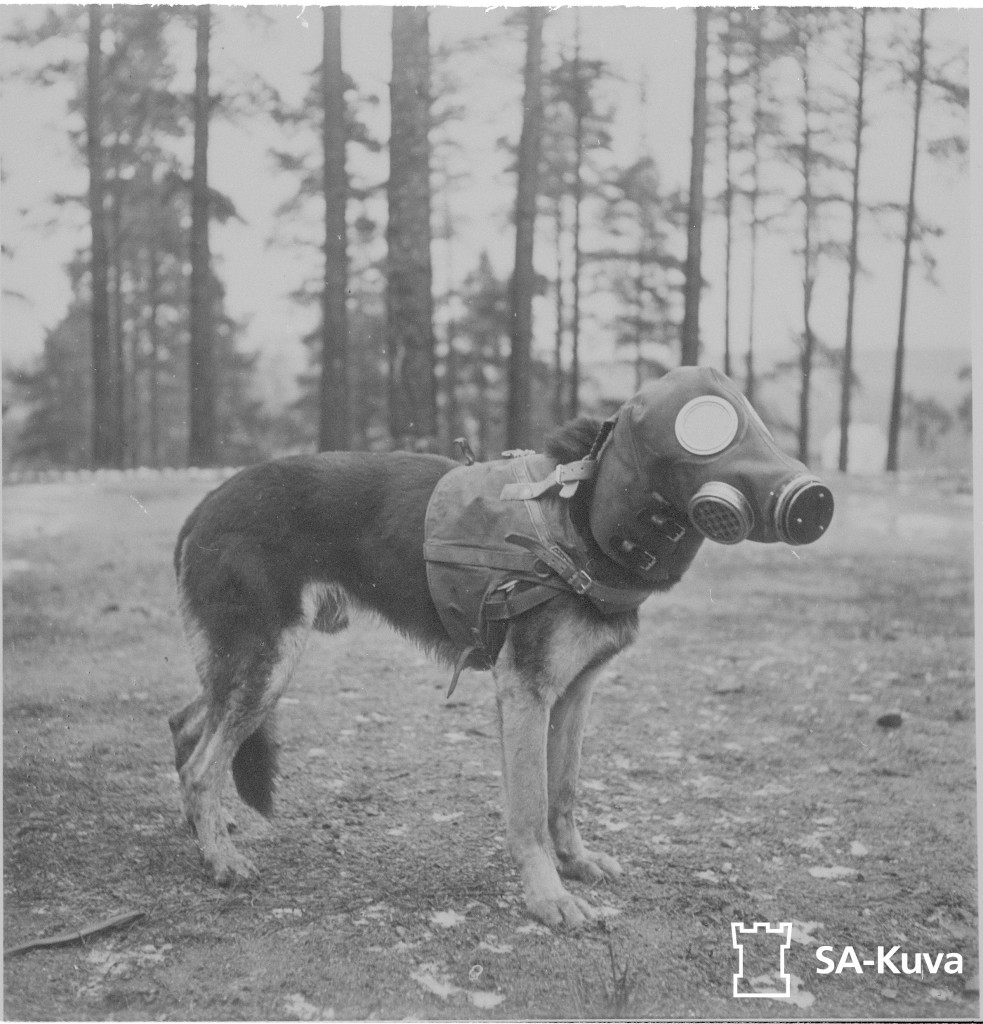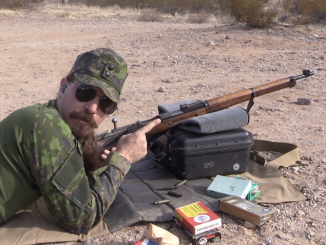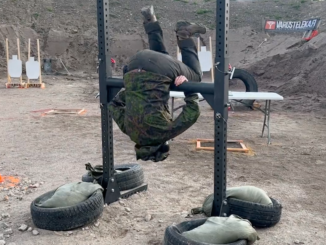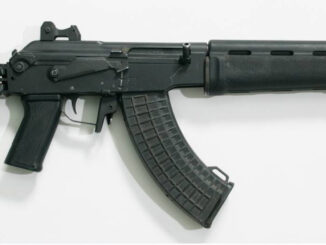
(photo from http://sa-kuva.fi/)
Finnish dog wearing a canine gas mask during the Winter War.

Finnish dog wearing a canine gas mask during the Winter War.

Finnish Brutality 2021 is going to be a tough match in the best case. But I will be running it in a 1940 uniform, with a Mosin. A Finnish M39 Mosin, sure, but still a […]

I am very happy to have had the chance to introduce my friend Dr. Jackson Crawford to Brutality matches this year, at Finnish Brutality 2022. I thought we should take a few minutes to sit […]

Finland adopted the AK in 7.62x39mm after World War Two, and continues to use the AK to this day. The standard pattern RK62 was starting to fall a bit short, and so in the late […]
© 2025 Forgotten Weapons.
Site developed by Cardinal Acres Web Development.

That dog looks as brain damaged as mine is.
I’m thinking this would have been very uncomfortable for the dog during heavy exertion in warmer weather since dogs regulate their body temperature mostly by panting, which would be pretty restricted in that gas mask.
Still, better than being exposed to toxic gases and dying in a most unpleasant way.
Quite true, Earl. Another problem (and one I recall from the short experience I had with a gas mask…) is condensation, something quite annoying even with modern masks. I can only imagine the level of stress such thing would entail for a dog!…
Excellent point, Ruy.
You should try the American style with the filters in the cheeks. They vent up around the lenses and reduce or eliminate condensation greatly!
Hi, Stewart :
Thank you for your input. While I do agree with you about the reduction in condensation and lower breathing resistance accruing to a dual filter system ( placing a filter opposite each cheek) for a typical modern air-purifying respirator, I think Ruy’s point is that such usage nevertheless still entails a certain amount of physical stress, especially under conditions of duress, and that the older-style respirators that did not have the advantages of the modern dual-filter system were much worse.For a dog, even a well-trained one, it would be that much more difficult.
The U.S. Army had similar masks for war dogs, and even had masks for cavalry and pack horses;
http://www.11uscavalry1940.com/Mc7.jpg
Oddly enough, most “horse masks” didn’t include eye protection.
None of them would have been useful against nerve agents, which can be absorbed through the skin, but of course at that time nobody outside of the German and possibly Japanese armies’ chemical warfare establishments even knew such agents had been developed.
It’s sort of difficult to devise a defense against something when you don’t even know it exists.
cheers
eon
Once you’ve enclosed the sniffer and the biter, the poor half-blind pup becomes more of a liability than an asset, you’d think..
Interestingly, the pictured mask seems to have a voicemeter, a device intended “for improved verbal communication capability”, so at least the poor doggie could at least bark… But Jamezb is right, I am afraid. I also supposed dogs must be trained to use gas masks, as humans for that matter!
This image is likely from either summer 1939 or some time during the Continuation War, not the Winter War. Then again, service dog training officially started at the turn of the ’20s.
This mask might’ve been meant for messenger dogs rather than attack, search or guard dogs.
My thoughts exactly. This is likely a courier dog, judging by the harness. I suppose the harness has a carrying bag for letters and communiques. There aren’t many telephones in the woods, you know.
Good point about it being a messenger dog. I haven’t thought about messenger dogs since I was a kid. I’m going to have to study up on it a bit now as with the Inet it is so much easier.
I really like these Saturday pictures and the comments they create. I get introduced to history and information that I otherwise wouldn’t. I has broadened my views on several topics. Especially when I’ve been able to follow up with some research/reading/etc.
I’m guessing you are correct in the deduction this is a messenger dog, I still wonder how well he could navigate with no scent following ability and diminished vision. I suppose for short distances or running from one end to the other of a trench he would fare pretty well.
Oh, I suppose they only put this getup on them during gas attacks and that they did not attempt to deliver messages with the masks on. What a crazy looking thing though. I wonder what the dog thought?
“GET THIS FREAKY BAG OFF ME!” is probably what Fido would have thought. One would have to then grab the dog and hide before any gas-masked attackers charge through the clouds of poison…
Are there any flammable poison gasses?
Generally, they tried to avoid that. For instance in Germany in 1914;
They were interested in any gas that could be put in a cast iron (as opposed to steel) shell casing because the whole point of gas to begin with was to economize on HE, and use less steel in making shell bodies; both were in short supply. (Google “Kitchener Shells Scandal” sometime; all the combatants had similar problems.)
The trouble with war gases was that most of them reacted with iron alloys, usually causing corrosion. Sooner or later, this resulted in a crack in the shell casing, and you had a leaking gas shell on your hands, which tended to ruin your whole day. Most combatants finally solved the problem with non-reactive lining materials like glass or even special paints or electrolytic coatings inside the shell cavity.
A “leaker” was bad enough with, say, phosgene or mustard gas. Now imagine what would happen if the gas was flammable on top of its other effects.
Army ordnance, and especially chemical ordnance, personnel generally prefer to deal with only one type of potential malfunction hazard at a time. Especially considering that most “malfunctions” in their line of work can take out an entire ammo dump at one go.
cheers
eon
Mustard Gas, which is really a liquid, is inflammable, although not very. White Phospherous is classified as a chemical filling and is very inflammable..
WP leakers are a PITA in storage, particularly in thin skinned natures such as grenades. You always have to have big tanks of water in WP stores for drowning leakers.
Never seen canine respirators before – mind you the Russians were good at producing strange kit like that..underwater rifles and the like..
Here’s the definitive answer, as per U.S. Army TM 3-215, “Military Chemistry and Chemical Agents”, December 1963, plus my best bud, ex-Army Chemical Recon;
Most chemical agents have a “flash point”, i.e. an ignition point, due to their chemical components. But generally the military does not use agents with flash points low enough for ignition by “normal” means, i.e. heat of the detonation of the charge that “cracks” the artillery shell, etc., to release the agent.
This is because if the chemical ignites and burns, it basically destroys itself, and does not generate the chemical (toxic/etc.) effect on the enemy it is intended to. You might get a small, briefly toxic cloud, but that would be about it.
The manual describes the properties of the common agents, ranging from lung injurants like phosgene to nerve agents , etc. Most are listed as having flash points high enough that they won’t ignite when dispersed by munition; phosgene, for instance, has no flash point and apparently pretty much can’t be “ignited”, period.
Hydrogen cyanide, by comparison, has a flash point low enough that it is ignited about 50% of the time by the shell bursting, and as such isn’t considered a useful (!) agent.
So, there you have it. With the exception of “deliberate” incendiaries, like napalm, and specialized chemical weapons, like white phosphorus which are intended to burn for other reasons, (generating smoke, etc.), military chemical agents (“war gases”) aren’t supposed to be flammable.
cheers
eon
Thanks for the additional comments.
Phosgene is also a by-product of carbon tetrachloride when the latter is exposed to air. It’s total non-flammability, as well as other properties as a heavy gas that tends to “smother” the area it covers and deprive that area of oxygen, is the main reason it was used extensively in early fire extinguishers — with warnings to would-be users to exercise extreme caution in its application due to this very property, and the fact that phosgene is, of course, highly toxic in sufficient concentration.
– )))))) Sorry for taking space for no good reason, but this is really p(h)unny.
Well, dogs are martial means too. We had them as integral part of border guards. The troops belonging to those units had “dog’s head” on their badges. Long tradition, apparently.
looking at his tail, he is not a happy dog. the site has 155159 images! not all this interesting though.
Good observation, Eric — thank you. That tail between his /her legs is a sure sign of unhappiness or distress.
On a different but related note, I remember Erich Maria Remarque writing in “All Quiet On The Western Front” via his assumed first-person character, Paul Baumer, how vile and inhumane it was to use horses ( and, by implication, other animals ) in war because of the suffering they endured when injured, and because they were being put into this situation and exploited by the selfish needs and wants of humans. Animals had even fewer options than the common foot soldiers who were sacrificed en masse in exchange for dubious results, in spite of the platitudes of the politicians and other leaders. Since Remarque’s novel is really very much an autobiography based directly on his personal experiences in the Great War, there is little — if any — doubt as to its authenticity.
Good point on Remarque and his masterpiece on the horrors of trench warfare, Earl. I think he was quite appalled by the sheer brutality of modern, total war. On a wider note, I think the Great War generation, or at least several writers with first-hand war experience reflected compassion for extreme animals’ exploitation carried to extremes under combat conditions amid the general unplesantness the “War to end all wars” was, horses and mules having suffered the most. Britain sent about a million horses to France during the war. Only 62,000 returned… As one of the inscriptions at the Animals in War memorial in London reads, “They had no choice”.
Based on my experiences with trying to get large dogs into Halloween costumes (obviously, one of those things a girlfriend thought would be “cute”) just getting a dog into that rig and then getting him to stand still long enough for a photo is a sign of an extremely well-trained pooch!
In the age of widespread IEDs, military dogs have taken on a bigger role than ever. I’ve seen (can’t find it, of course) an absolutely incredible (and heartrending) documentary about bomb dogs in Afghanistan, a lot of it taken from soldiers’ helmetcams. I did find this 60 Minutes episode that is pretty fascinating:
http://www.youtube.com/watch?v=FsnPAQ137fY
From what I’ve heard and read, the traditional target priority of insurgents in ambush has been modified from “officers and radiomen first” to “dogs first.”
The Animals in War memorial in London sounds like a destination, if I ever make it to London. I’ve been to the grave of Greyfriars’ Bobby in Edinburgh – the dog who slept on his owner’s grave for a decade – and it’s another example of the respect that the Brits and Scots have for animals.
@ Ruy & Jim :
Thank you for the compassionate comments and for the links. It was very moving to read what you had to say.
Speaking of the Great War, among the many fine books about World War One is “Some Desperate Glory” ( Simon & Schuster, 1981 ) by Edwin Campion Vaughan, who served as a young second lieutenant in the front lines ( including the murderous Passchendaele Offensive ) and was one of the few junior-level commissioned officers of his generation to survive the war. The book, published 50 years after his death with the blessings of his family, was essentially a personal war diary and, as such, was written entirely from the point of view of everyday conditions in the trenches. What struck me about his writing was how the vicissitudes of trench warfare were referred to in an almost matter-of-fact manner while not concealing the real horror beneath, which is understandable if one were trying to keep a record like this and still survive while doing one’s duty, one day — or one hour — at a time.
When I was in my specialty training for the US Air Force, I had to watch a number of films of nuclear explosions and their actual aftermath, among other things. One that saw struck me, it was from China, and it showed an Army exercise where a cavalry unit moved through a radiated or simulated radiated area… and the horses were equipped with NBC gear.
The dogs though, they are wonderful. They have saved so many lives in this latest war. I had the privilege of spending some time with some AF canine troops. They are unusual people and very in tune with their dogs. It’s a sight to behold.